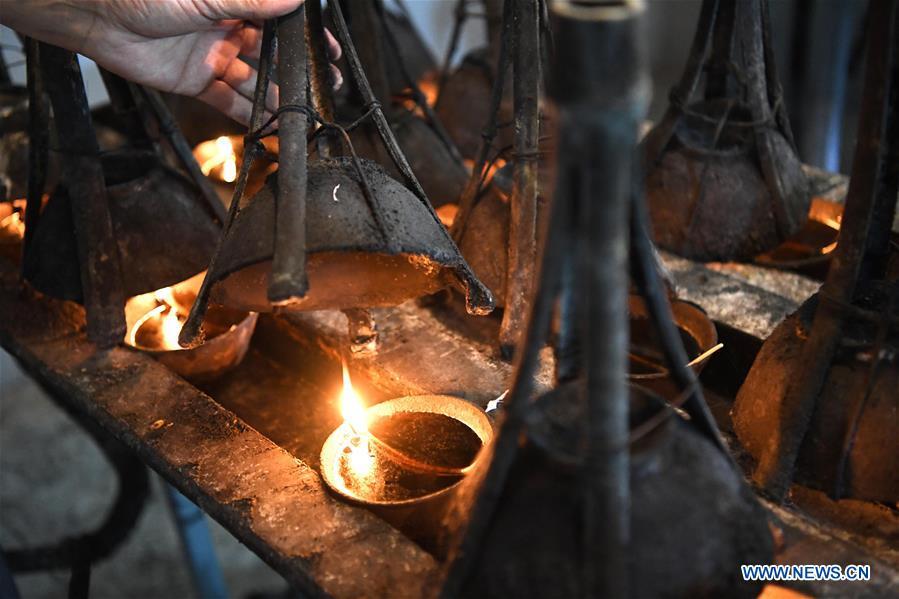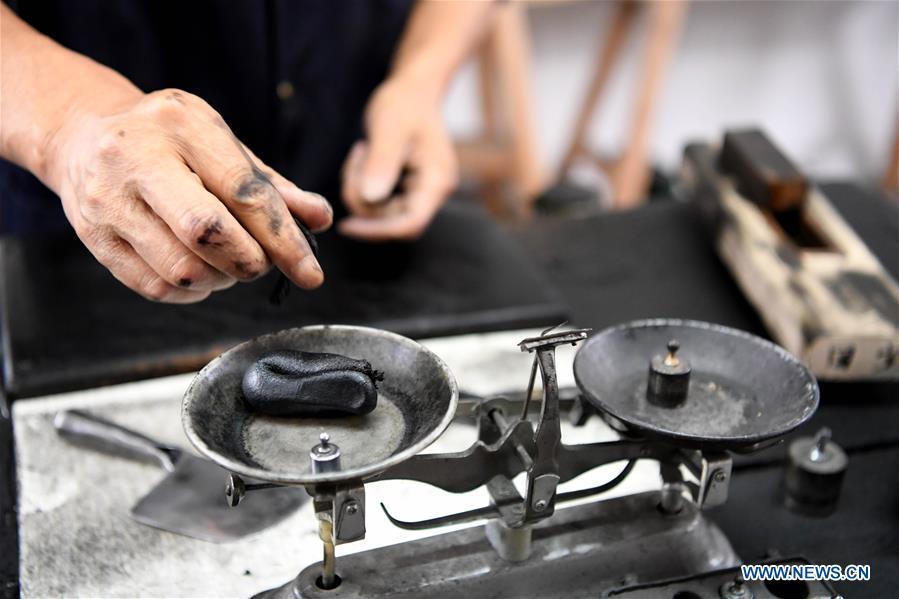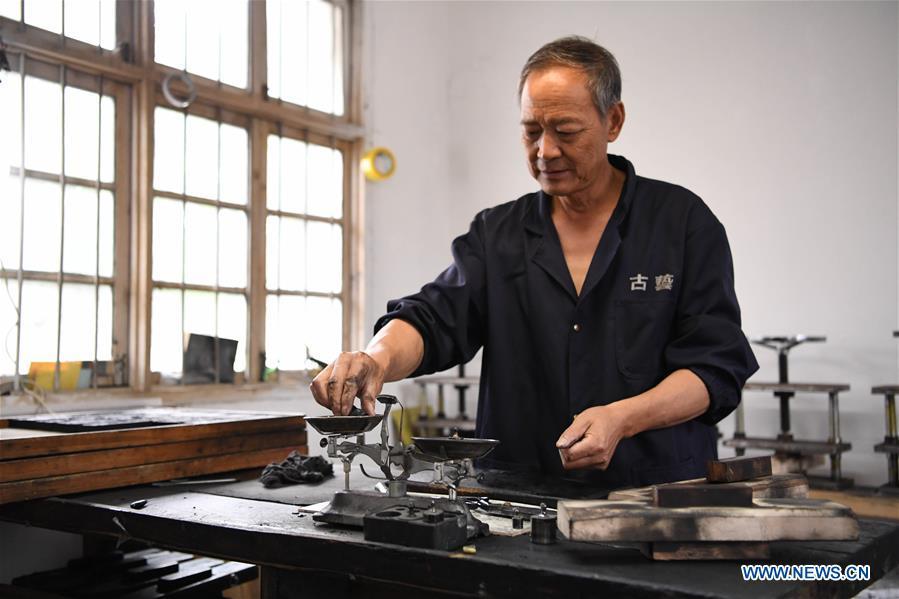
Wang Chunlin collects the soots of burnt oil to make oil soot inksticks in Jingde County, east China's Anhui Province, July 4, 2019. Wang Chunlin, a provincial-level inheritor of traditional handmade oil soot ink making in Anhui, started learning to make oil soot ink from his father at the age of 14. The oil soot inkstick made with traditional techniques from the soot of burnt tung oil or various other oils lines with smooth and bright luster. Along with the inkstone, brush, and paper, the inkstick is considered one of the "Four Treasures of the Study" in classical Chinese literary culture. (Xinhua/Huang Bohan)

Wang Chunlin weighs oil soot inkstick mud in Jingde County, east China's Anhui Province, July 4, 2019. Wang Chunlin, a provincial-level inheritor of traditional handmade oil soot ink making in Anhui, started learning to make oil soot ink from his father at the age of 14. The oil soot inkstick made with traditional techniques from the soot of burnt tung oil or various other oils lines with smooth and bright luster. Along with the inkstone, brush, and paper, the inkstick is considered one of the "Four Treasures of the Study" in classical Chinese literary culture. (Xinhua/Huang Bohan)

Wang Chunlin prepares to collect the soots of burnt oil for oil soot inksticks making in Jingde County, east China's Anhui Province, July 4, 2019. Wang Chunlin, a provincial-level inheritor of traditional handmade oil soot ink making in Anhui, started learning to make oil soot ink from his father at the age of 14. The oil soot inkstick made with traditional techniques from the soot of burnt tung oil or various other oils lines with smooth and bright luster. Along with the inkstone, brush, and paper, the inkstick is considered one of the "Four Treasures of the Study" in classical Chinese literary culture. (Xinhua/Huang Bohan)

Wang Chunlin weighs oil soot inkstick mud in Jingde County, east China's Anhui Province, July 4, 2019. Wang Chunlin, a provincial-level inheritor of traditional handmade oil soot ink making in Anhui, started learning to make oil soot ink from his father at the age of 14. The oil soot inkstick made with traditional techniques from the soot of burnt tung oil or various other oils lines with smooth and bright luster. Along with the inkstone, brush, and paper, the inkstick is considered one of the "Four Treasures of the Study" in classical Chinese literary culture. (Xinhua/Huang Bohan)

Wang Chunlin kneads raw material of oil soot inkstick in Jingde County, east China's Anhui Province, July 4, 2019. Wang Chunlin, a provincial-level inheritor of traditional handmade oil soot ink making in Anhui, started learning to make oil soot ink from his father at the age of 14. The oil soot inkstick made with traditional techniques from the soot of burnt tung oil or various other oils lines with smooth and bright luster. Along with the inkstone, brush, and paper, the inkstick is considered one of the "Four Treasures of the Study" in classical Chinese literary culture. (Xinhua/Huang Bohan)

Wang Chunlin dries oil soot inksticks in Jingde County, east China's Anhui Province, July 4, 2019. Wang Chunlin, a provincial-level inheritor of traditional handmade oil soot ink making in Anhui, started learning to make oil soot ink from his father at the age of 14. The oil soot inkstick made with traditional techniques from the soot of burnt tung oil or various other oils lines with smooth and bright luster. Along with the inkstone, brush, and paper, the inkstick is considered one of the "Four Treasures of the Study" in classical Chinese literary culture. (Xinhua/Huang Bohan)

Wang Chunlin makes an oil soot inkstick in Jingde County, east China's Anhui Province, July 4, 2019. Wang Chunlin, a provincial-level inheritor of traditional handmade oil soot ink making in Anhui, started learning to make oil soot ink from his father at the age of 14. The oil soot inkstick made with traditional techniques from the soot of burnt tung oil or various other oils lines with smooth and bright luster. Along with the inkstone, brush, and paper, the inkstick is considered one of the "Four Treasures of the Study" in classical Chinese literary culture. (Xinhua/Huang Bohan)

Wang Chunlin collects the soots of burnt oil to make oil soot inksticks in Jingde County, east China's Anhui Province, July 4, 2019. Wang Chunlin, a provincial-level inheritor of traditional handmade oil soot ink making in Anhui, started learning to make oil soot ink from his father at the age of 14. The oil soot inkstick made with traditional techniques from the soot of burnt tung oil or various other oils lines with smooth and bright luster. Along with the inkstone, brush, and paper, the inkstick is considered one of the "Four Treasures of the Study" in classical Chinese literary culture. (Xinhua/Huang Bohan)

Wang Chunlin dries oil soot inksticks in Jingde County, east China's Anhui Province, July 4, 2019. Wang Chunlin, a provincial-level inheritor of traditional handmade oil soot ink making in Anhui, started learning to make oil soot ink from his father at the age of 14. The oil soot inkstick made with traditional techniques from the soot of burnt tung oil or various other oils lines with smooth and bright luster. Along with the inkstone, brush, and paper, the inkstick is considered one of the "Four Treasures of the Study" in classical Chinese literary culture. (Xinhua/Huang Bohan)

Wang Chunlin grinds oil soot inkstick in Jingde County, east China's Anhui Province, July 4, 2019. Wang Chunlin, a provincial-level inheritor of traditional handmade oil soot ink making in Anhui, started learning to make oil soot ink from his father at the age of 14. The oil soot inkstick made with traditional techniques from the soot of burnt tung oil or various other oils lines with smooth and bright luster. Along with the inkstone, brush, and paper, the inkstick is considered one of the "Four Treasures of the Study" in classical Chinese literary culture. (Xinhua/Huang Bohan)





